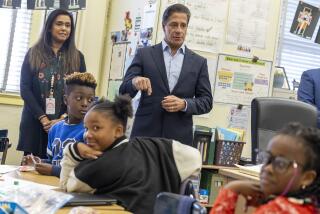Retired Los Angeles teacher keeps at it, for free
Five mornings a week, Bruce Kravets, 66, puts on a coat and tie, straps on his helmet and bikes to work at Palms Middle School on L.A.’s Westside, where he teaches math. For free.
Last June, after 42 years of teaching, Kravets retired. He’d put so much money into his retirement fund over the decades, his monthly compensation if he stepped down would be greater than his regular pay. But that didn’t mean he was ready to abandon teaching. His plan was to stay on and teach for no salary, because he couldn’t think of anything more fun or rewarding than teaching algebra, geometry, logic and stage craft.
A no-brainer, right? Kravets is, by all accounts, a truly gifted teacher, and in a district with a budget crisis, here was a guy who said, “Keep your money, I’ll do it gratis.”
Ahhh, but this is LAUSD, and for months after he announced his plan, it was looking as if Kravets would be told thanks, but no thanks. At one point over the summer, I was told by a Los Angeles Unified administrator that Palms would lose funding if Kravets taught class, because the daily attendance of his students wouldn’t be counted if he was an unpaid teacher.
It looked bad for Kravets, so a bittersweet retirement party was thrown for him at the end of the school year. Among those in attendance were students from all the way back to the 1960s. That’s the kind of teacher Kravets is, the type you remember the rest of your life.
When LAUSD Supt. Ray Cortines caught wind of what was happening, he wasn’t happy. He told his staff to iron out the paperwork and get Kravets back in the classroom.
Finally, toward the end of August, Kravets was officially invited back. When I dropped in on him one day last week to see what the magic is all about, it seemed to me that he may be good for another 42 years. Kravets, who had only two sick days in four decades, told me he’s having as much fun now as ever.
In his seventh-grade algebra class, a student raised her hand and said she had forgotten her textbook.
“How would you feel if your book came to school without you?” asked Kravets.
A parent had told me Kravets has an “absent-minded professor style,” and I think I know what he meant, although Kravets is anything but absent-minded. A better way to put it is that he seems oblivious to the world at large. Kravets dwells unself-consciously in his own horn-rimmed universe of equations filled with Xs and Ys, his hair curled by the heat of his passion for problem-solving.
Principal Bonnie Murrow said Kravets brings this total commitment to school each day, gladly working with students on his lunch break or after school if they need help or just want to hang out.
David Feigin, who had Mr. Kravets for math in the 1960s and has remained close to him since, recalls playing problem-solving games with the teacher after school. Sometimes Kravets would take students out for pizza and have them measure the diameter of the pie and run an equation to determine the best bargain -- small, medium or large.
Feigin took to writing “B.K. reports” to update fellow students on lunch hour gatherings or field trips. At the retirement party in June, Feigin scribbled a note on the teacher’s blackboard, and it’s still there.
“After 40 years, B.K. finally retired. But, he won’t go away. Oh, the horror. If he comes to your class asking, ‘Can I teach?’ let him in, and pretend to listen.”
There is no pretending, though.
Students last week sat transfixed as Kravets scribbled on an overhead projector that y = mx15, and 5x + 2y = 10, as he helped his class compute the distance in kilometers that sound waves travel through water.
There was no fidgeting, giggling or texting. Kravets would call on a student and ask him or her to state aloud how to solve a problem, and he would stick with that student until there was complete understanding. He told me he’s always taught by the Socratic method, believing that the process is as important as the right answer.
I expected students to wilt under that pressure, but no one did. They were unself-conscious and understood that Kravets would not embarrass them in the process of teaching them. It helps, Kravets later told me, that all his classes are for gifted students, which he called a dream situation for any teacher.
At one point, Kravets and a student both struggled with an equation until the student pointed out that Kravets had graphed it incorrectly.
“When you’re correcting me, it means I’m teaching you,” he said.
Kravets had students write an equation in notation function to determine how much a dolphin eats in a day. It looked like this: y = 0.05x, with X as the dolphin’s weight of 460 pounds.
It took a few minutes, but the student Kravets called on came up with 23 pounds of food daily.
“You might want to think about that,” Kravets said, “before you buy a dolphin.”
On his lunch break, Kravets ate with fellow teachers George Weston, Larry Rubin and Leonel Lopez, who talked him up. Lopez said it was “a great inspiration” to see so many of Kravets’ students show up at his retirement party.
Another teacher, Michael Schneider, had a sheet of math problems and asked Kravets if he wouldn’t mind offering a bit of advice on one of those classic junior high problems. If two guys dig holes at different rates of speed, how quickly would they dig one hole working together?
Schneider knew both the formula and the answer, but he asked the veteran Kravets for some guidance on the best teaching approach. Kravets pulled out a pencil and quickly scribbled some notations. Schneider was grateful for the help; Kravets was happy to oblige.
Before he went off to his next class, I asked Kravets if his wife, a part-time teacher, wanted him to truly retire so they could spend more time together.
No way, he said.
“She wants me out of the house.”
Back in the classroom, students Jeffrey Guo, Lisa Sobajian and Lisa Takahashi said Kravets is tough in a good way and that once you get used to his quirks and passions, you appreciate him all the more.
I asked Guo if he ever squirms, though, when Kravets calls on him.
“No,” he said.
Why not?
“Because I know the answers.”
More to Read
Sign up for Essential California
The most important California stories and recommendations in your inbox every morning.
You may occasionally receive promotional content from the Los Angeles Times.











